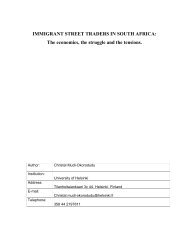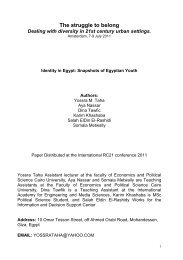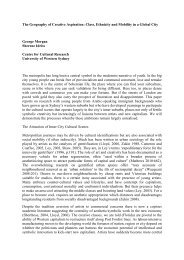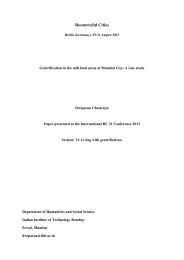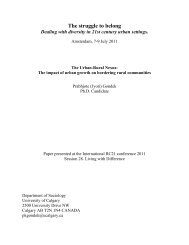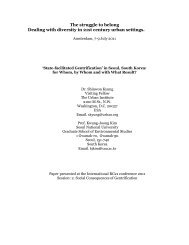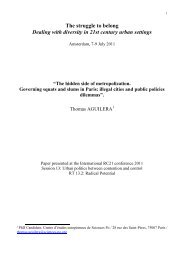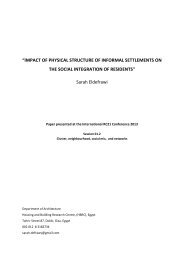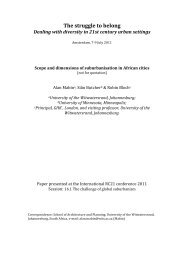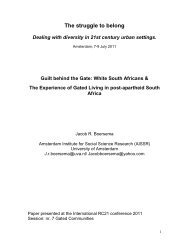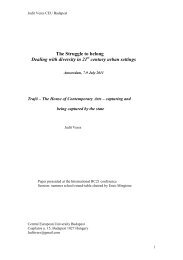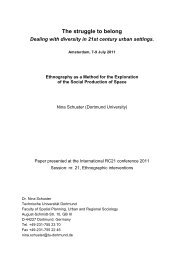Fragmentation as a threat to social cohesion - RC21 ORG ...
Fragmentation as a threat to social cohesion - RC21 ORG ...
Fragmentation as a threat to social cohesion - RC21 ORG ...
You also want an ePaper? Increase the reach of your titles
YUMPU automatically turns print PDFs into web optimized ePapers that Google loves.
fragmentation refers much more <strong>to</strong> a transformation of public spaces than that of<br />
residential spaces (Navez-Bouchanine 2002b, 62). Here, an important field of<br />
research considers the privatization and surveillance of public spaces <strong>as</strong> one of the<br />
defining elements of the fragmentary city (e.g. Siebel/Wehrheim 2003). Fear and<br />
insecurity are also seen <strong>as</strong> the main driving forces <strong>to</strong> privatization and gating,<br />
probably the most elaborated empirical reference <strong>to</strong> fragmentation studies (e.g. Low<br />
2005). These, obviously, relate fragmentation <strong>to</strong> a cl<strong>as</strong>sic view of segregation, where<br />
<strong>social</strong>ly homogenous residential units characterize urban space. <strong>Fragmentation</strong> in<br />
this sense emph<strong>as</strong>izes the disconnection and exclusivity of distinct elite residential<br />
units and serves more <strong>as</strong> a description of their fortification. Within approaches that<br />
seek <strong>to</strong> cl<strong>as</strong>sify fragmentation <strong>as</strong> the new socio-spatial pattern of cities (e.g., “microfragmentation”,<br />
according <strong>to</strong> Caldeira, 1996, or “multi-fragmentation”, according <strong>to</strong><br />
Fischer/Parnreiter, 2002), it remains mostly unclear how this is supposed <strong>to</strong><br />
characterize a qualitative shift in the socio-spatial organization of cities. Rather, these<br />
approaches relate <strong>to</strong> fiercer or smaller-scale segregation and a resulting higher grade<br />
of complexity. The analytical and qualitative shift, though, <strong>as</strong> h<strong>as</strong> been shown in the<br />
conceptual reflection of fragmentation, lies within its dialectic of connection and<br />
disconnection, or, deconstruction and reconstruction.<br />
Probably the most overarching theoretical concept <strong>to</strong> <strong>social</strong> science literature on<br />
urban fragmentation is that of postmodern urbanism. Notions such <strong>as</strong> the “splintering<br />
metropolis” (Graham 2001) or the “fractal city” (Soja 2000) relate <strong>to</strong> this conceptual<br />
context. Key elements within the different approaches <strong>to</strong> this field of research are<br />
“spatial fragmentation and disaggregation” (Murray 2004, 142), mostly within multicentered<br />
urban regions (Soja 2000), characterized by a “pluralization of former<br />
collective identities” (Momma<strong>as</strong> 1996, 209) and/or the fact that “urban <strong>social</strong> order<br />
can no longer be defined effectively by such conventional and familiar modes of<br />
<strong>social</strong> stratification <strong>as</strong> the cl<strong>as</strong>s-divided Dual City of the bourgeoisie and the<br />
proletariat; the neatly layered Hierarchical City of the wealthy, the middle cl<strong>as</strong>s, and<br />
the poor; or the 'two Americ<strong>as</strong>' Racially Divided City of black versus white” (Soja<br />
2000, 265). Politically, this is not only related <strong>to</strong> the breaking up of cl<strong>as</strong>s-b<strong>as</strong>ed<br />
political affiliations (Momma<strong>as</strong> 1996, 210), but also <strong>to</strong> a shift <strong>to</strong> neoliberal modes of<br />
urban governance (Murray 2004, 142).<br />
In urban geographical research the phenomenon of fragmentation appears mainly <strong>as</strong><br />
socio-spatial fragments (e.g. spaces of exclusion versus spaces of inclusion),<br />
physical-material spaces (e.g. style of housing) or <strong>as</strong> diverse spatial functions (e.g.<br />
spaces for living, consumption or leisure). Within the discipline of geography, urban<br />
fragmentation is often limited <strong>to</strong> determining the polarization of “poor” and “wealthy”<br />
or <strong>to</strong> analyzing access possibilities <strong>to</strong> public or private spaces (especially privatized,<br />
formerly public spaces). Generally, the visible spatial structures are particularly<br />
important <strong>as</strong> they are a product of political, economic or <strong>social</strong> fac<strong>to</strong>rs (e.g. changing<br />
lifestyles, living arrangements and preferences, consumption patterns, etc.). Thus,<br />
fragmentation is mainly used in the sense of connected or disconnected/excluded<br />
parts of the city or society.<br />
At the end of the 1990s, urban geography conducted a conceptual shift <strong>to</strong>wards a<br />
more political perspective. The correlations between urban planning and society, and<br />
the new debates about the interdependency of fragments formerly considered <strong>as</strong><br />
isolated were identified <strong>as</strong> the essential issues for understanding cities. The focus of<br />
interest shifted <strong>to</strong> the finding that the built fortification of some parts of the city<br />
endangers <strong>social</strong> <strong>cohesion</strong>. Therefore, it became clear that not the perception of a<br />
6 Deffner, Hoerning: <strong>Fragmentation</strong> <strong>as</strong> a Threat <strong>to</strong> Social Cohesion?



